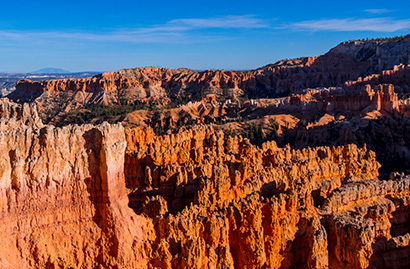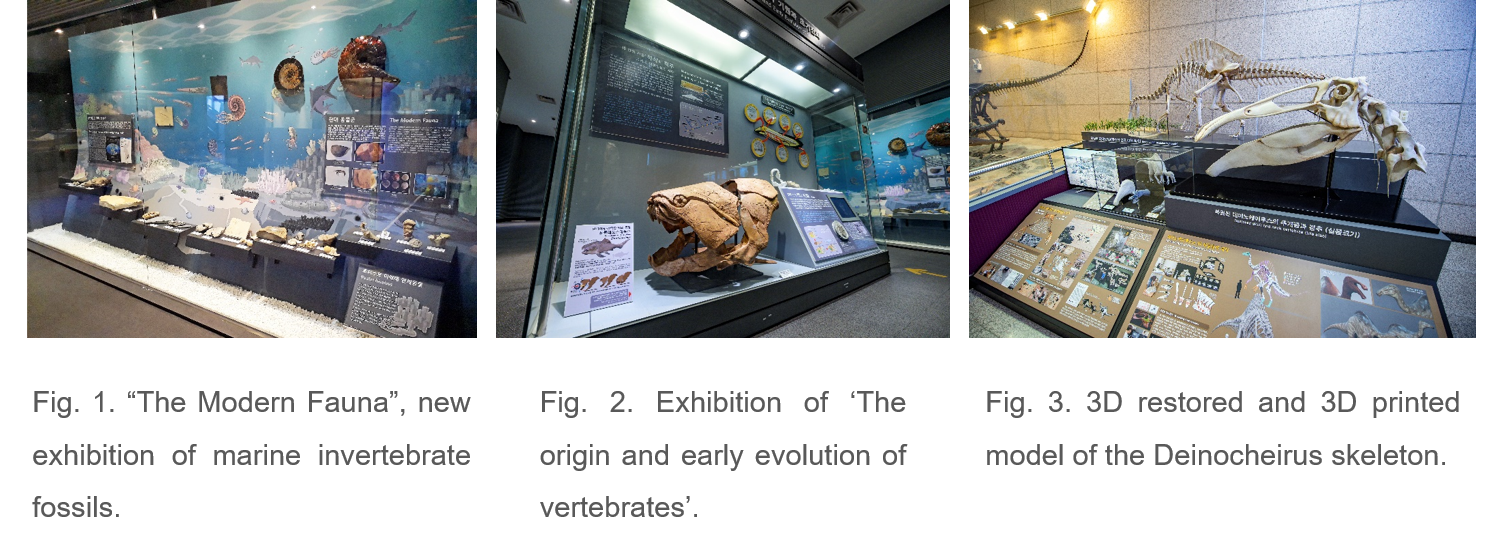
The Geological Museum systematically collects, manages, preserves, and displays domestic and overseas geological samples, such as minerals, rocks, and fossils, which provide information about the formation of the Korean Peninsula, the earth, and the evolution of life. The Geological Museum is taking the lead in popularizing geosciences not only through basic research on geologic samples but also through various special exhibitions as well as education and docent interpretation programs.
>> museum.kigam.re.kr
INDOOR PERMANENT EXHIBITION REORGANIZATION
Since 2018, exhibitions of marine invertebrate fossils have been expanded to inform the public of evolutionary trends of invertebrates through the Phanerozoic. This year “the Modern Fauna” was newly exhibited. This fauna is characterized by the dominance of mollusks and crustaceans since the Mesozoic. Finally, exhibitions of Phanerozoic marine invertebrate fossils based on the scientific concept of “evolutionary fauna” have been completed. In the Modern Fauna exhibition, Cenozoic fossil oysters, snails, and brittle stars from Korea are displayed, as well as overseas ammonites, clams, shrimps, and crab fossil specimens. Of interest is the rudist bivalve fossils that flourished to form huge reefs under the shallow tropical sea from the Jurassic and then went extinct at the end of Cretaceous. The large illustration of the Mesozoic shallow marine environment enables visitors to vividly imagine the underwater ecosystem of the Modern Fauna.
In addition, the preexisting ‘Structure and Evolution of Birds’ booth in the 1st Exhibition Hall was replaced by new topics, the ‘Origin and Early Evolution of Vertebrates’ and the ‘Evolution of Bony fishes & Origin of Tetrapods’. The new exhibitions were planned as part of the ‘Early evolution of vertebrates’ exhibition plan to reorganize the scattered exhibition lines of vertebrates. They show the origin of vertebrates and the evolutionary background of the jaws that allowed them to surpass invertebrates, the evolutionary trails of bony fish, and the characteristics of early tetrapods (like changes from fins to limbs, etc.) for terrestrial entry.
Lastly, in the Main Hall, the world’s first 3D-restored prototype model of the Deinocheirus skeleton was displayed. Except for the first known forelimbs, the rest of its skeletons was discovered by a team of the Geological Museum (KIGAM) and the study results were published in the journal Nature in 2014. Interestingly, Deinocheirus had carnivore-like forelimbs with big and curved claws, although it proved to be an herbivore. After 3D computer graphic restoration through comparative anatomy using deformed and damaged skeletons as well, a whole skeleton (quarter scale) and a skull (life size) model were produced by 3D printing technique. Visitors can encounter the interesting extinct animal in the museum.
Contact: Seung-bae Lee (sblee@kigam.re.kr)
Hang-Jae Lee (fossilis@kigam.re.kr)

OUTDOOR EXHIBITION AND EDUCATION CONTENTS IMPROVEMENT
The Geologic Time Street of Korea (Geologic Street hereafter), which was made in 2015, displays representative rocks of Korea for each geologic era. Near the entrance of the Geologic Street, there is a rock garden with larger rocks. Previously, explanation panels in the Geologic Street were difficult for visitors, and there was a lack of adequate deion of rocks or instructions for the rock garden. In addition, these areas did not attract visitors because of their location, which was remote from the museum. In order to attract more visitors to these outdoor exhibition areas, we complemented the exhibits. Magnifier models were attached at proper positions on the rocks and key points for observation were written thereon to teach visitors how to observe rocks in the Rock Garden. On Geologic Street, a large photo zone was installed at the entrance as a landmark to invite more visitors and let them cherish their memories. The explanation panels were revised to focus on the major geologic events that the Korean Peninsula experienced during each geologic era. Name tags were added to the representative rock specimens with supplementary deions.
The Geological Museum has developed and utilized workbooks for children to study geological specimens and the history of the earth while visiting indoor exhibition halls. However, no workbook had been developed for the outdoor exhibitions. This year an outdoor exhibition workbook was made for elementary school students for Geologic Street and the Rock Garden. In addition, considering that there are many families that visit, a guidebook was developed for parents who are not familiar with geology, so they can teach their children. The workbook involves stamping, sticker-pasting, and crossword puzzle pages to give students an interest in geological activities. The guidebook was made easy with visual aids and educational tips. For example, pictures of the geological map of Korea and formation processes of rocks were inserted to help understanding, and useful knowledge on geological science related to the principal formation history of the Korean Peninsula and its rocks was also included. The workbook for elementary school students will be upgraded continuously, and new workbooks for people of other ages will be created. Complementary work on the outdoor exhibition and the outdoor workbook and guidebook are expected to increase visitor interest in geological science and the geology of the Korean Peninsula, where they live.
Contact: Dong Seop Yoon (yds9104@kigam.re.kr)
Ye Hee Jeong (cyh1040@kigam.re.kr)
